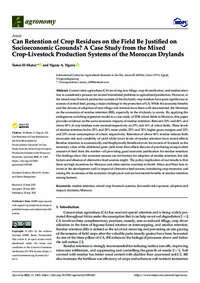Can Retention of Crop Residues on the Field Be Justified on Socioeconomic Grounds? A Case Study from the Mixed Crop-Livestock Production Systems of the Moroccan Drylands

Authors:
Conservation agriculture (CA) involving zero tillage, crop diversification, and residue retention
is considered a panacea for several interrelated problems in agricultural production. However, in
the mixed crop-livestock production systems of the drylands, crop residues have great significance as
sources of animal feed, posing a major challenge in the promotion of CA. While the economic benefits
and the drivers of adoption of zero tillage and rotation have been well documented, the literature
on the economics of residue retention (RR), especially in the drylands, is scanty. By applying the
endogenous switching regression model to a case study of 2296 wheat fields in Morocco, this paper
provides evidence on the socio-economic impacts of residue retention. Between 30% and 60% and
above 60% of crop residues were retained respectively on 35% and 14% of wheat fields. These levels
of residue retention led to 22% and 29% more yields, 25% and 32% higher gross margins and 22%
and 25% more consumption of wheat, respectively. Retention of above 60% residue reduces both
downside risk and variability of yield while lower levels of residue retention have mixed effects.
Residue retention is economically and biophysically beneficial even for owners of livestock as the
monetary value of the additional grain yield more than offsets the cost of purchasing an equivalent
amount of feed from the market—all providing good economic justification for residue retention.
Our findings show that economic reasons are not barriers for adoption of residue retention, but risk
factors and absence of alternative feed sources might. The policy implication of our results is that
there are high incentives for Morocco and other similar countries in North Africa andWest Asia to
invest in the development and/or import of alternative feed sources, introducing crop insurance, and
raising the awareness of the economic, biophysical and environmental benefits of residue retention
among farmers.
